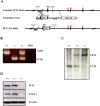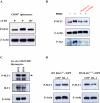The orphan adapter protein SLY1 as a novel anti-apoptotic protein required for thymocyte development
- PMID: 19604361
- PMCID: PMC2717057
- DOI: 10.1186/1471-2172-10-38
The orphan adapter protein SLY1 as a novel anti-apoptotic protein required for thymocyte development
Abstract
Background: SH3 containing Lymphocyte Protein (SLY1) is a putative adapter protein exclusively expressed in lymphocytes which is involved in antigen receptor induced activation. We previously have generated SLY1Delta/Delta mice harbouring a partial deletion in the N-terminal region of SLY1 which revealed profound immunological defects in T and B cell functions.
Results: In this study, T cell development in SLY1-/- and SLY1Delta/Delta mice was analysed ex vivo and upon cultivation with the bone marrow stromal cell line OP9. SLY1-deficient thymocytes were compromised in inducing nutrient receptor expression and ribosomal protein S6 phosphorylation, indicating a defect in mTOR complex activation. Furthermore, SLY1 was identified as a novel anti-apoptotic protein required for developmental progression of T cell precursors to the CD4+CD8+ double-positive stage by protecting from premature programmed cell death initiation in developing CD4-CD8- double-negative thymocytes. In addition, SLY1 phosphorylation was differentially regulated upon Notch ligand-mediated stimulation and expression of the preTCR.
Conclusion: Thus, our results suggest a non-redundant role for SLY1 in integrating signals from both receptors in early T cell progenitors in the thymus.
Figures







References
-
- Godfrey DI, Kennedy J, Mombaerts P, Tonegawa S, Zlotnik A. Onset of TCR-beta gene rearrangement and role of TCR-beta expression during CD3-CD4-CD8-thymocyte differentiation. J Immunol. 1994;152:4783–4792. - PubMed
-
- Strasser A, Huang DC, Vaux DL. The role of the bcl-2/ced-9 gene family in cancer and general implications of defects in cell death control for tumourigenesis and resistance to chemotherapy. Biochim Biophys Acta. 1997;1333:F151–F178. - PubMed
-
- Cory S, Vaux DL, Strasser A, Harris AW, Adams JM. Insights from Bcl-2 and Myc: malignancy involves abrogation of apoptosis as well as sustained proliferation. Cancer Res. 1999;59:1685s–1692s. - PubMed
Publication types
MeSH terms
Substances
LinkOut - more resources
Full Text Sources
Molecular Biology Databases
Research Materials
Miscellaneous

